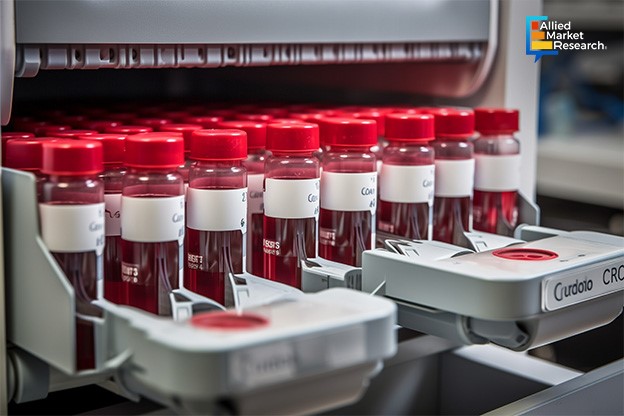Promising Role of Flow Cytometry in Advancing Drug Discovery and Cell Analysis

23 May
2024
Key Takeaways:
- Flow cytometry and drug discovery
- AI in flow cytometry
- Regions and countries maximizing the use of flow cytometry
- Promising alliances made by leading players
Flow cytometry is a laser-based technique used for detecting and analyzing the detailed chemical and physical characteristics of cells and particles. This technique is mostly used to evaluate bone marrow, peripheral blood, and other fluids in the human body. During this process, a sample of cells or particles is suspended in fluid and injected into a flow cytometer machine. Nearly 10,000 cells can be analyzed and processed by a computer in less than one minute. Flow cytometry is used in research for various purposes including cell counting, cell sorting, identifying cell characteristics, detecting microorganisms, finding biomarkers, and diagnosis and potential treatment of blood and bone marrow cancers.
Flow cytometry in drug discovery and development
This cutting-edge technique plays a pivotal role in the drug discovery process by providing a powerful tool for analyzing cellular responses, identifying target populations, and assessing the efficacy and safety of new drugs. The process allows for the rapid analysis of millions of cells in a short period, enabling high-throughput screening of potential cells that can be used for drug discovery. In this method, multiple parameters such as cell size, granularity, and the expression of various markers, are also measured, providing comprehensive data on cellular responses to drug.
Furthermore, by identifying and profiling cell surface markers and intracellular proteins, the technique helps in pinpointing specific cell populations that a drug targets. Various functional assays use this technique to confirm the biological relevance of targets by assessing cellular functions such as proliferation, apoptosis, and signaling pathway activation. In addition, the method is instrumental in discovering biomarkers that help predict drug response or resistance. These biomarkers can then be validated in clinical samples, aiding patient satisfaction and personalized medicine approaches.
Incorporation of AI – A transformative shift in flow cytometry
Nowadays, modern technologies are transforming every field. In flow cytometry analysis, each cell is represented by one dot or a scatterplot. Dots on plots probably represent cells, but they are not cells. However, a lot of valuable information is left off the paper. To overcome this issue, a team of scientists at Thermo Fisher Scientific developed a first-of-its-kind automated image analysis software for the Invitrogen™ Attune™ CytPix™ flow cytometer that has brought significant transformation in flow cytometer. By utilizing AI-based algorithms, the software has developed the potential capture of up to 6,000 focused, centered images per second. It also offers 4 lasers and 14 florescent parameters, enabling professionals with image-enhanced flow cytometry.
Regions promoting the use of flow cytometry
The flow cytometry industry is analyzed across different regions and countries. Among all, the North America region held the highest market share in 2022 and is expected to remain dominant during the forecast period. This is mainly due to the rise in the prevalence of cancer and the presence of key market players across the region. However, the landscape across Asia-Pacific is expected to be fastest growing over the analysis period due to the increase in the number of geriatric populations and the rise in demand for minimally invasive treatment across the region.
Based on country, India is predicted to manifest the highest CAGR of 12.6% from 2023 to 2032. However, Mexico is expected to rank second in terms of growth, with a CAGR of 11.6% over the forecast period.
Pioneering moves of top players to enhance cell analysis solutions
To provide full-cell analysis solutions to individuals across the globe, several leading companies in this industry have made beneficial strategies such as mergers, acquisitions, partnerships, and collaborations. For instance, in February 2023, Cytek Biosciences, Inc., a leading cell analysis solutions company, announced to acquire assets related to the Flow Cytometry & Imaging (FCI) business unit of DiaSorin, an Italian multinational biotechnology company that produces and markets in vitro diagnostics reagent kits used in immunodiagnostics and molecular diagnostics. With this acquisition, the companies aimed to offer complete cell analysis solutions by combining high-resolution cell images with the speed, sensitivity, and phenotyping abilities of flow cytometry.
Similarly, in August 2022, BD (Becton, Dickinson and Company), a leading global medical technology company collaborated with LabCorp (NYSE: LH), a renowned global life science company to create a framework for developing, manufacturing, and commercializing flow cytometry-based companion diagnostics intended to match patients with life-changing treatments for cancer and other critical diseases.
To wrap up, the expanding applications of flow cytometry in various fields including oncology, hematology, and stem cell research are expected to create wide growth opportunities for the industry in the forthcoming years. Moreover, the increase in demand for personalized medicine among individuals across the globe is going to fuel the growth of the landscape exponentially in the future.
To gain more insights into the flow cytometry industry, talk to our industry experts today! They will also help you identify potential investment opportunities across various regions.

Rosy Behera
Author's Bio- Rosy Behera holds a bachelor’s degree in Electrical and Electronics Engineering and now she is a content writer by profession. She loves to portray her thoughts and ideas with a nice command of words. Grabbing an audience with her creative write-ups is one of her biggest assets so far. Apart from writing, she is a certified “Odisi” dancer and has done Gardharva in Drawing, Painting, and Arts. She always explores new things through travel and is a big foodie.
Top 4 Investment Areas in the Generative AI in Healthcare Industry That Are Set to Transform the Medical Sector in 2024
Avenue: Entire Library membership of Allied Market Research Reports at your disposal
- Avenue is an innovative subscription-based online report database.
- Avail an online access to the entire library of syndicated reports on more than 2,000 niche industries and company profiles on more than 12,000 firms across 11 domains.
- A cost-effective model tailored for entrepreneurs, investors, and students & researchers at universities.
- Request customizations, suggest new reports, and avail analyst support as per your requirements.
- Get an access to the library of reports at any time from any device and anywhere.
Related Post
-
How are Submarine Cables Transforming Global Connectivity with Enhanced User Experience?
-
Endoscopy Procedures: Transformations in Techniques and Applications
-
AI-Powered Video Analytics: How the Product Actually Works for enterprises
-
Painting Robots: Transforming Precision Coating and Creative Applications
-
Innovations in Pharmacovigilance Systems Advancing Patient Safety
-
Understanding Edge Security: Keeping Data Safe Near the Source
-
Exploring the Use and Advancements of 3D Laser Scanners in Professional Applications
-
Reinforcing Industrial Controls with Smarter Tools and Training








